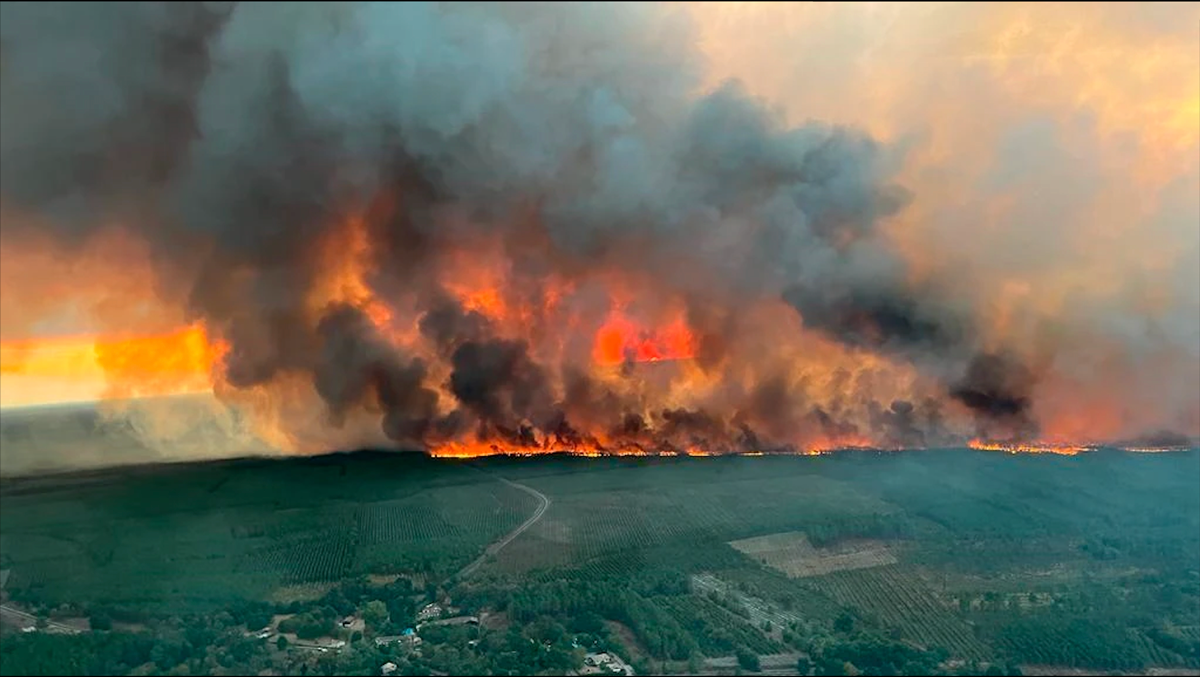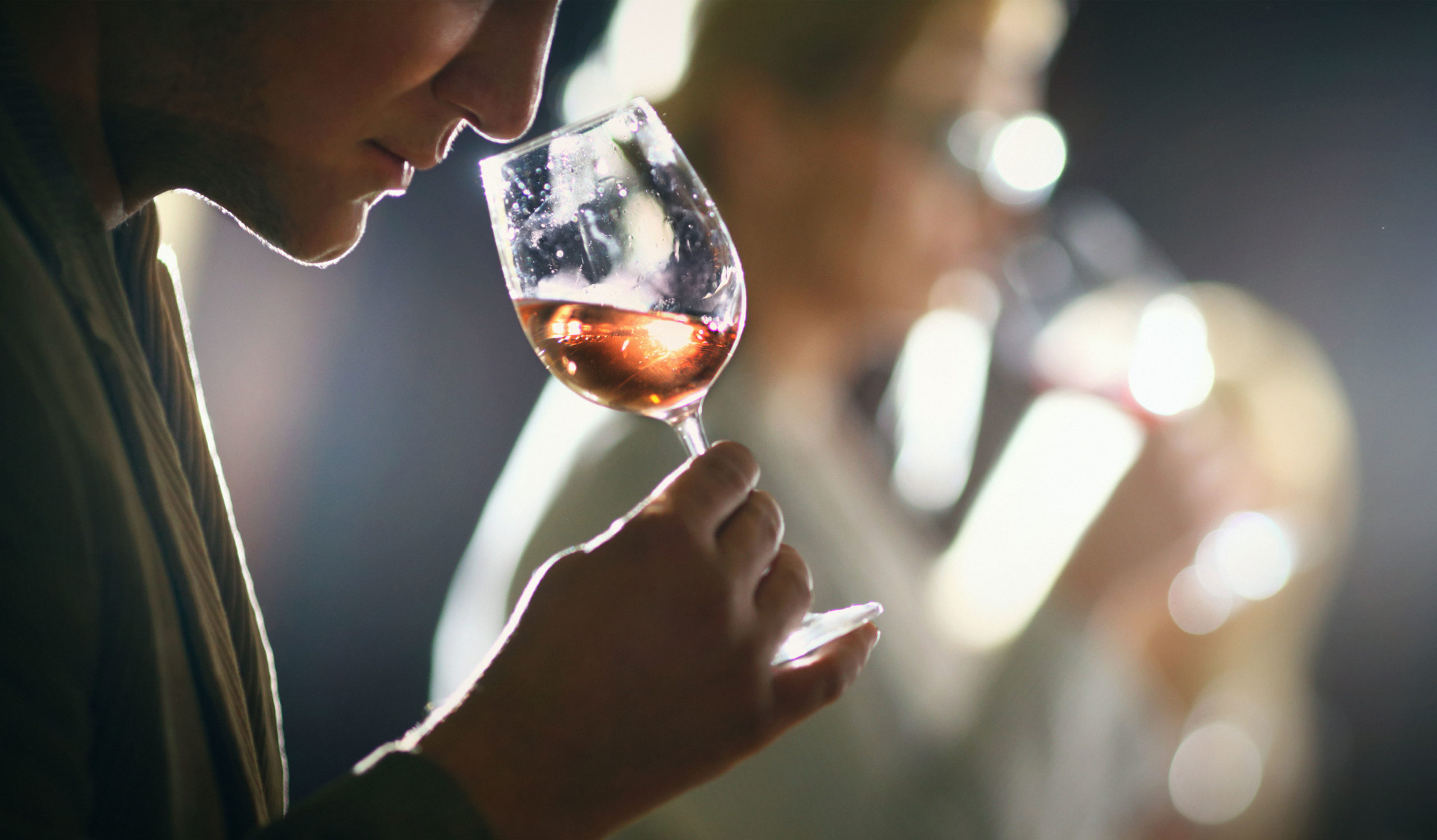
Wine Culture Magazine

Above, a fire described as “a monster, an ogre” rages near Bordeaux’s vineyards in August. It was the region’s
second major wildfire this summer. Photo provided by the fire brigade of the Gironde region.
You’ve got to have a lot of sympathy for farmers these days. The changing climate keeps throwing jab after jab, punch after unpredictable punch, pushing farmers up against the ropes and fighting to stay on their feet. This is climate change, blow after blow of extremes that rock from one cruel extravagance to another.
One such ruthless assault on farmers around the world is the combination of searing temperatures and lack of rainfall that together have turned vast parts of the globe into a giant tinder box just waiting to spark into an incredible imitation of hell. The resulting wildfires have rocked the wine industry. Some will point out that wildfires in some areas are a natural occurrence that helps keep some ecosystems healthy. But these fires are becoming more extreme, more widespread and more intense. And they are affecting grape growers and winemakers around the world. So what are people doing about it?
First, we should dispel a myth. The presence of smoke in the air in a wine region does not automatically mean that all the grapes and wines will have smoke taint. It is much more complicated than that. “Taint” is also a harsh word. Some of the same compounds in smoke also come out of barrels and a little smokiness can often be quite OK in a wine. So, the term smoke “impact” is probably a better one to use.
Like anything to do with wine, it is all about balance. Just like too much oak, Brettanomyces, volatile acidity, sweetness or lack of acidity can turn many people off a wine, so, too, can the flavour of smoke. A little bit of smokiness can add complexity to a wine. But it can quickly become too much and few consumers crave the taste of Don Draper’s heavily used ashtray in their wine.
Scientists and winemakers are absorbing information fast. Wine country wildfires being a relatively new phenomenon (at least in size and frequency), the learning curve is steep. Experiments are being done at every step of the grape-growing and winemaking process, from the vineyard through to the final wine.
Research is showing that the way smoke impact works is that the free volatile phenols from the smoke latch on to the grape and stick with it through the entire ripening and winemaking process.
What is confusing, though, and has the experts scrambling to understand, is how much the smoke can vary in its impact on different grapes and different wines. There seems to be a direct correlation with the specific growth stage the vine is in. Even a tiny difference can mean one grape variety gets a heavy dose of smoke while in the very next row another variety is hardly affected. The proximity, intensity, composition and length of exposure are all key factors, but the correlations aren’t direct, nor simple. Sometimes a wine that appears to be free of smoke can later release the flavours after an indeterminate time in barrel or bottle. The head scratching continues.
There is no silver bullet for removing smokiness in wine, but a number of techniques have been found to reduce its perception. The more of these are used, the better the result.
The first step should be analysis or micro-ferments that can determine the likelihood of smoke influence. Hand harvesting can keep fruit whole and exclude leaves, which can carry traces of smoke. Avoiding skin contact with whole cluster pressing is another technique that keeps smoke away from the juice—it’s how white Pinot Noir is made. It also helps to keep temperatures cool during processing and separate free run from harder pressed juice.
In addition, experiments are underway to develop sprays that might protect grapes from smoke, but there is still much work ahead.
Post-production is where the most can be currently done. Carbon is being widely used to fine out some of the smoky flavour, but it unfortunately can strip out other desirable flavours as well. Oak chips can mask the smoky perception a little, as does blending in unaffected wine. Reverse osmosis and other membrane filtrations will do the trick, too, but it has sometimes been found the smoke will return over time.
The potential for smoke showing up later on can be avoided by making wines designed to drink now rather than to store in the cellar. Be ready for less tannic, juicier wines. Who really has room for a big wine cellar these days anyway?
Climatic extremes and the risk of forest fires aren’t going away any time soon, but don’t underestimate the ability for the wine business to bounce back. With a world of very smart brains working hard on the problem, the wine business is ready for a fight.

Getty Images photo
Although smoke impact is getting a lot of attention these days, it is estimated that 20 to 25 per cent of the population can’t actually smell or taste smoke compounds in wine.
Because smoke attaches itself to the skin of the grape, one way to avoid its impact on wine is to use only the juice and avoid as much skin contact as possible. That’s how white Pinot Noir is made, and it’s a growing category here in B.C. Here are three to try. —Vitis staff

Spearhead Winery White Pinot Noir 2021
(Southeast Kelowna, B.C., $28)
Gooseberry, honeydew, lime zest, elderflower, crisp.

Beaumont Family Estate White Pinot Noir 2021
(West Kelowna, B.C., $26)
Green apple, juicy pear, lemon, bright.

Silkscarf Winery White Pinot 2021
(Summerland, B.C., $26)
Peach, strawberry, white flower, delicate, vivid.

Rhys Pender is a Master of Wine who combines his time writing, judging, teaching, consulting and dirtying his boots at his four-acre vineyard and winery, Little Farm Winery, in the Similkameen Valley.

Rhys Pender is a Master of Wine who combines his time writing, judging, teaching, consulting and dirtying his boots at his four-acre vineyard and winery, Little Farm Winery, in the Similkameen Valley.
Copyright © 2025 - All Rights Reserved Vitis Magazine